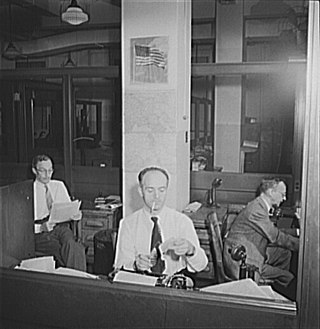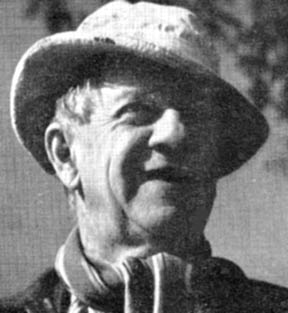
Print syndication distributes news articles, columns, political cartoons, comic strips and other features to newspapers, magazines and websites. The syndicates offer reprint rights and grant permissions to other parties for republishing content of which they own and/or represent copyrights. Other terms for the service include a newspaper syndicate, a press syndicate, and a feature syndicate.

Harry Hershfield was an American cartoonist, humor writer and radio personality. He was known as "the Jewish Will Rogers". Hershfield also was a columnist for the New York Daily Mirror. His books include Laugh Louder, Live Longer and Now I'll Tell One. As a comics artist he is best remembered for his newspaper comic Abie the Agent.
United Feature Syndicate, Inc. (UFS) is a large American editorial column and comic strip newspaper syndication service based in the United States and established in 1919. Originally part of E. W. Scripps Company, it was part of United Media from 1978 to 2011, and is now a division of Andrews McMeel Syndication. United Features has syndicated many notable comic strips, including Peanuts, Garfield, Li'l Abner, Dilbert, Nancy, and Marmaduke.

The Newspaper Enterprise Association (NEA) is an editorial column and comic strip newspaper syndication service based in the United States and established in 1902. The oldest syndicate still in operation, the NEA was originally a secondary news service to the Scripps Howard News Service; it later evolved into a general syndicate best known for syndicating the comic strips Alley Oop, Our Boarding House, Freckles and His Friends, The Born Loser, Frank and Ernest, and Captain Easy / Wash Tubbs; in addition to an annual Christmas comic strip. Along with United Feature Syndicate, the NEA was part of United Media from 1978 to 2011, and is now a division of Andrews McMeel Syndication. The NEA once selected college All-America teams, and presented awards in professional football and professional [NBA] basketball.

Frank Merriwell is a fictional character appearing in a series of novels and short stories by Gilbert Patten, who wrote under the pseudonym Burt L. Standish. The character appeared in over 300 dime novels between 1896 and 1930, numerous radio dramas in 1934 and again from 1946 through 1949, a comic strip from 1928 through 1936, a comic book Frank Merriwell At Yale, and a 12-chapter serialized film in 1936. The book series was relaunched in 1965, but only three books were published.

Funnies on Parade is an American giveaway publication of 1933 that was a precursor of comic books. The eight-page publication featured reprints of such popular syndicated comic strips as The Bungle Family, Joe Palooka, Keeping Up with the Joneses, Mutt and Jeff, Reg'lar Fellers, and Somebody's Stenog. Creators included F. O. Alexander, Gene Byrnes, Al Capp, Clare Victor Dwiggins, A. E. Hayward, C. M. Payne, Al Smith, and Harry J. Tuthill.
A comic strip syndicate functions as an agent for cartoonists and comic strip creators, placing the cartoons and strips in as many newspapers as possible on behalf of the artist. A syndicate can annually receive thousands of submissions, from which only two or three might be selected for representation. In some cases, the work will be owned by the syndicate as opposed to the creator. The Guinness World Record for the world's most syndicated strip belongs to Jim Davis' Garfield, which at that point (2002) appeared in 2,570 newspapers, with 263 million readers worldwide.

The McNaught Syndicate was an American newspaper syndicate founded in 1922. It was established by Virgil Venice McNitt and Charles V. McAdam. Its best known contents were the columns by Will Rogers and O. O. McIntyre, the Dear Abby letters section and comic strips, including Joe Palooka and Heathcliff. It folded in September 1989.

The Washington Post Writers Group (WPWG), a division of The Washington Post News Service & Syndicate, is a press syndication service distributing opinion columnists, breaking news, podcasts and video journalism, lifestyle content, and graphics and data visualizations. The service is operated by The Washington Post.

Clare Victor Dwiggins was an American cartoonist who signed his work Dwig. Dwiggins created a number of comic strips and single-panel cartoons for various American newspapers and newspaper syndicates from 1897 until 1945, including his best-known strip, the long-running School Days.
George Matthew Adams was an American newspaper columnist and founder of the George Matthew Adams Newspaper Service, which syndicated comic strips and columns to newspapers for five decades. His own writings were circulated widely to The Gettysburg Times and many other newspapers.
The Bell Syndicate, launched in 1916 by editor-publisher John Neville Wheeler, was an American syndicate that distributed columns, fiction, feature articles and comic strips to newspapers for decades. It was located in New York City at 247 West 43rd Street and later at 229 West 43rd Street. It also reprinted comic strips in book form.
The Central Press Association was American newspaper syndication company based in Cleveland, Ohio. It was in business from 1910 to 1971. Originally independent, it was a subsidiary of King Features Syndicate from 1930 onwards. At its peak, the Central Press supplied features, columns, comic strips, and photographs to more than 400 newspapers and 12 million daily readers. Notable comic strips that originated with Central Press include Brick Bradford, Etta Kett, and Muggs McGinnis.
Strange as It Seems appeared as a syndicated cartoon feature published from 1928 to 1970, and became a familiar brand to millions around the globe for its comic strips, books, radio shows and film shorts. Created by John Hix, Strange as It Seems was distinguished for its adherence to Hix's standard that every published fact be verified by a minimum of three sources. In Hix's words, Strange as It Seems is a library of "the curious, in nature and humankind, set adrift on the vast sea of public opinion with the hope that it will fulfill its mission to entertain and acquaint its viewers with some of the marvels of the world in which we live."
The Public Ledger Syndicate was a syndication company operated by the Philadelphia Public Ledger that was in business from 1915 to circa 1950. The Ledger Syndicate distributed comic strips, panels, and columns to the United States and the United Kingdom, Ireland, Canada, Sweden, New Zealand, and Australia. The syndicate also distributed material from the Curtis Publishing Company's other publications, including The Saturday Evening Post, Ladies' Home Journal, and The Country Gentleman.
The New York Herald Tribune Syndicate was the syndication service of the New York Herald Tribune. Syndicating comic strips and newspaper columns, it operated from c. 1914 to 1966. The syndicate's most notable strips were Mr. and Mrs., Our Bill, Penny, Miss Peach, and B.C. Syndicated columns included Walter Lippmann's Today and Tomorrow, Weare Holbrook's Soundings, George Fielding Eliot's military affairs column, and John Crosby's radio and television column. Irita Bradford Van Doren was book review editor for a time.
The National Newspaper Syndicate, originally known as the John F. Dille Co., was a syndication service that operated from 1917 to c. 1984. It was founded by Chicago businessman John F. Dille and specialized in comic strips and gag cartoons. It also carried advice columns, such as Paul Popenoe's "Modern Marriage." It is most well known for syndicating Buck Rogers, considered by many to be the first adventure comic strip.
Associated Newspapers, Inc. was a print syndication service of columns and comic strips that was in operation from 1912 to c. 1966. The syndicate was originally a cooperative of four newspapers: The New York Globe, the Chicago Daily News, The Boston Globe, and the Philadelphia Bulletin. Associated Newspapers was led by Henry Herbert McClure (1874-1938), a cousin of S. S. McClure, founder of the McClure Syndicate, the first American newspaper syndicate. In 1930, Associated Newspapers was acquired by and became a subsidiary of the Bell Syndicate. The syndicate's most successful, long-running strip was Gladys Parker's Mopsy.
The New York World was one of the first newspapers to publish comic strips, starting around 1890, and contributed greatly to the development of the American comic strip. Notable strips that originated with the World included Richard F. Outcault's Hogan's Alley, Rudolph Dirks' The Captain and the Kids, Denys Wortman's Everyday Movies, Fritzi Ritz, Gus Mager's Hawkshaw the Detective, Victor Forsythe's Joe Jinks, and Robert Moore Brinkerhoff's Little Mary Mixup.








